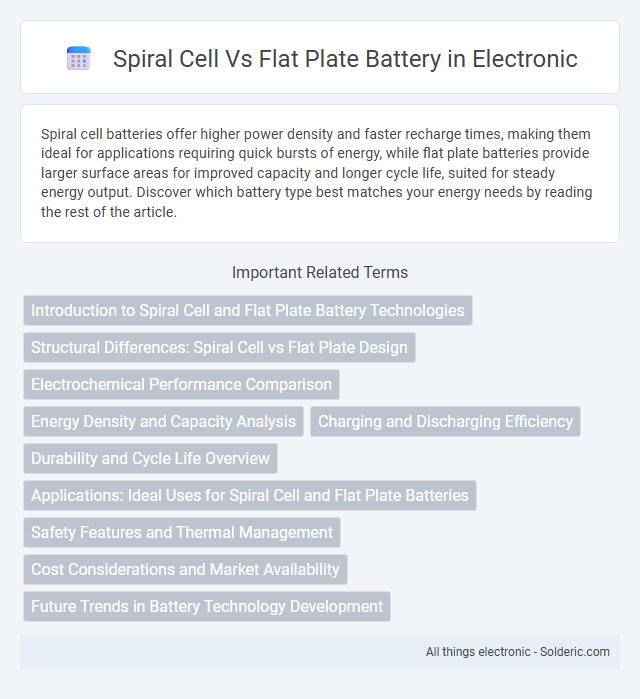Spiral cell batteries offer higher power density and faster recharge times, making them ideal for applications requiring quick bursts of energy, while flat plate batteries provide larger surface areas for improved capacity and longer cycle life, suited for steady energy output. Discover which battery type best matches your energy needs by reading the rest of the article.
Comparison Table
| Feature | Spiral Cell Battery | Flat Plate Battery |
|---|---|---|
| Design | Coiled electrode plates in a cylindrical shape | Flat, stacked electrode plates in a rectangular shape |
| Energy Density | Moderate energy density | Higher energy density due to larger plate area |
| Durability | Good resistance to vibration and shock | Excellent cycle life and durability under heavy loads |
| Maintenance | Lower maintenance due to sealed design | Requires regular maintenance and electrolyte checking |
| Cost | Generally higher due to complex manufacturing | Lower manufacturing cost and easier repair |
| Common Applications | Automotive starter batteries, portable devices | Industrial use, backup power, renewable energy storage |
Introduction to Spiral Cell and Flat Plate Battery Technologies
Spiral cell battery technology features electrodes rolled into a compact, cylindrical form, enabling high energy density and efficient heat dissipation, commonly used in automotive and power tool applications. Flat plate battery technology utilizes flat, rectangular electrodes stacked parallel, providing ease of manufacturing and cost-effectiveness, widely employed in stationary energy storage and backup power systems. Both technologies leverage lead-acid chemistry but differ in design structure, impacting performance characteristics like charge acceptance, durability, and maintenance requirements.
Structural Differences: Spiral Cell vs Flat Plate Design
Spiral cell batteries feature electrodes rolled into a cylindrical shape, maximizing surface area within a compact volume and enhancing heat dissipation. Flat plate batteries use flat, rectangular electrodes stacked in parallel, offering simpler manufacturing and ease of inspection but potentially less efficient space utilization. Your choice between these designs impacts battery performance, size, and thermal management based on specific application needs.
Electrochemical Performance Comparison
Spiral cell batteries exhibit higher power density and faster charge-discharge rates due to their increased electrode surface area and improved electrolyte flow dynamics compared to flat plate batteries. Flat plate batteries typically provide greater energy capacity and longer cycle life, benefiting applications requiring steady, high-capacity discharge. The electrochemical performance of spiral cells is optimized for high current pulses, whereas flat plate designs excel in sustained energy delivery and enhanced thermal management.
Energy Density and Capacity Analysis
Spiral cell batteries offer higher energy density compared to flat plate batteries, enabling more energy storage within a compact space, which is ideal for applications requiring lightweight and space-efficient power solutions. Flat plate batteries typically provide greater capacity, delivering prolonged power output suitable for high-drain or continuous-use scenarios. When considering your energy needs, understanding the trade-off between the spiral cell's compact energy density and the flat plate's extended capacity can guide optimal battery selection.
Charging and Discharging Efficiency
Spiral cell batteries generally exhibit higher charging and discharging efficiency due to their cylindrical design, which allows for better heat dissipation and reduced internal resistance compared to flat plate batteries. Flat plate batteries often experience greater energy loss during charge and discharge cycles because of their larger surface area and slower thermal management, impacting overall efficiency. Optimizing your battery choice for applications requiring rapid charge and discharge will benefit from the superior efficiency of spiral cell technology.
Durability and Cycle Life Overview
Spiral cell batteries exhibit superior durability and longer cycle life due to their compact design and efficient heat dissipation, which reduces internal stress and degradation over time. Flat plate batteries, while often more cost-effective, typically experience shorter cycle life and faster capacity loss because of uneven electrode wear and less optimal thermal management. Choosing between the two depends on application requirements, with spiral cells favored for high-performance needs demanding extended longevity.
Applications: Ideal Uses for Spiral Cell and Flat Plate Batteries
Spiral cell batteries excel in applications requiring high power density and rapid charge-discharge cycles, such as in automotive starters, portable power tools, and UPS systems. Flat plate batteries are preferred for stationary energy storage, renewable energy systems, and industrial backup power, offering reliability and longer service life under deep discharge conditions. Selecting the appropriate battery depends on specific demands for energy delivery speed, cycle life, and spatial constraints in the intended application.
Safety Features and Thermal Management
Spiral cell batteries offer superior safety features due to their cylindrical design, which enhances pressure containment and reduces the risk of thermal runaway compared to flat plate batteries. Their advanced thermal management benefits from increased surface area and efficient heat dissipation, ensuring stable performance under high load conditions. Your choice of battery should consider these factors for applications requiring enhanced safety and consistent thermal regulation.
Cost Considerations and Market Availability
Spiral cell batteries often come with higher manufacturing costs due to their complex construction and tighter tolerances, impacting overall price and limiting widespread market availability primarily to specialized applications such as automotive starters. Flat plate batteries feature simpler designs and cost-effective production processes, making them more affordable and readily available for general consumer and industrial use. Your choice depends on budget constraints and the specific application requiring either high power density or broad accessibility.
Future Trends in Battery Technology Development
Spiral cell batteries offer higher energy density and faster charge-discharge cycles, making them suitable for emerging electric vehicles and renewable energy storage applications. Flat plate batteries, known for reliability and ease of manufacturing, are evolving with advancements in electrode materials to improve lifespan and efficiency. Your choice between these technologies should consider future trends emphasizing rapid charging, enhanced durability, and integration with smart energy systems.
Spiral cell vs Flat plate battery Infographic

 solderic.com
solderic.com